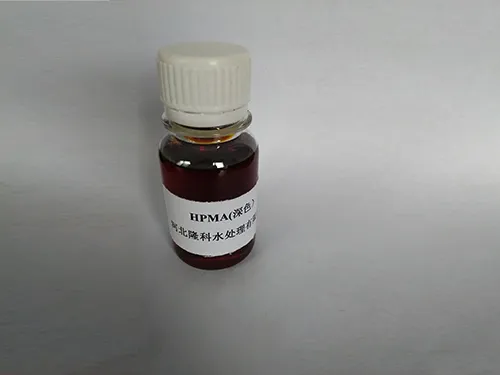Hydrolyzed Polymaleic Anhydride: Structure, Properties, and Applications
Anhidridi polimalik i hidrolizuar is a widely used polymer, especially in its hydrolyzed form. Hydrolyzed Polymaleic Anhydride is a product obtained by the hydrolysis reaction of PMA in aqueous solution, which leads to the opening of the circular structure of PMA, thereby endowing Hydrolyzed Polymaleic Anhydride with unique structure, properties, and applications. This article will focus on exploring the structural characteristics, key properties, and applications of Hydrolyzed Polymaleic Anhydride in different fields.

PMA itself is a vinyl polymer with anhydride side chains
The structural feature of HPMA is that repeated maleic anhydride units are arranged along the polymer main chain. When PMA comes into contact with water, a hydrolysis reaction occurs, causing the anhydride ring to break and convert into two carboxylic acid groups. This process converts PMA into Anhidridi polimalik i hidrolizuar, which carries a large number of carboxyl groups on its main chain, making it highly hydrophilic and pH sensitive. The structure of Hydrolyzed Polymaleic Anhydride changes from a hydrophobic cyclic structure to a hydrophilic chain structure, carrying a large amount of negative charge.
The key properties of Hydrolyzed Polymaleic Anhydride are closely related to its structure
Due to its high content of carboxylic acid groups, HPMA has excellent water solubility and can form stable solutions in water. Meanwhile, Hydrolyzed Polymaleic Anhydride exhibits significant pH sensitivity. Under acidic conditions, carboxylic acid groups remain protonated, and intermolecular forces are relatively strong. As the pH value increases, the carboxylic acid groups gradually deprotonate, forming negative charges, resulting in increased electrostatic repulsion between molecules, polymer chain stretching, and increased solution viscosity. This pH sensitivity makes Hydrolyzed Polymaleic Anhydride potentially applicable in many fields.
Hydrolyzed Polymaleic Anhydride has a wide range of applications, mainly due to its excellent water solubility, pH sensitivity, and good biocompatibility
Hydrolyzed Polymaleic Anhydride is widely used as a drug delivery carrier in the pharmaceutical field. It can covalently bind with drugs to form polymer drug conjugates, achieving targeted delivery and sustained release of drugs. By controlling the molecular weight and structure of Anhidridi polimalik i hidrolizuar, the release rate of drugs can be regulated, the efficacy of drugs can be improved, and side effects can be reduced. In addition, Hydrolyzed Polymaleic Anhydride is also used to manufacture biomaterials such as tissue engineering scaffolds and biosensors.
In the field of agriculture, Hydrolyzed Polymaleic Anhydride can be used as a soil amendment and fertilizer enhancer
It can improve soil structure, enhance soil water retention capacity and nutrient utilization efficiency, thereby promoting plant growth. Hydrolyzed Polymaleic Anhydride can also be combined with fertilizers to form slow-release fertilizers, reducing nutrient loss and improving fertilizer utilization efficiency.
In the industrial field, Hydrolyzed Polymaleic Anhydride is widely used as a dispersant, scale inhibitor, and water treatment agent
It can disperse pigments, fillers, and mineral particles to prevent their aggregation and precipitation. Hydrolyzed Polymaleic Anhydride can also inhibit the formation of scale and extend the service life of equipment. In addition, Hydrolyzed Polymaleic Anhydride can also be used for wastewater treatment to remove heavy metal ions and other pollutants from water.
In summary, Hydrolyzed Polymaleic Anhydride is a polymer with significant application value. Its structural characteristics endow it with excellent water solubility, pH sensitivity, and good biocompatibility. Hydrolyzed Polymaleic Anhydride plays an important role in the fields of medicine, agriculture, and industry. With the deepening of research, the potential application areas of Hydrolyzed Polymaleic Anhydride will continue to expand, making greater contributions to the development of various industries.
Hydrolyzed Polymaleic Anhydride FAQs
What is the main function of Hydrolyzed Polymaleic Anhydride?
Hydrolyzed Polymaleic Anhydride is an efficient polymer for water treatment, with main functions including:
Scale inhibition: Inhibiting the deposition of inorganic salts such as calcium carbonate and calcium sulfate through lattice distortion and dispersion;
Dispersion: adsorbed on the surface of particles to prevent the aggregation and deposition of suspended solids;
Corrosion inhibition: It assists in protecting the metal surface, but its corrosion inhibition performance is weaker than specialized corrosion inhibitors (such as organic phosphonates).
What water quality conditions is Hydrolyzed Polymaleic Anhydride suitable for?
Hydrolyzed Polymaleic Anhydride is particularly suitable for:
High hardness and high alkalinity water quality (such as circulating cooling water and boiler water);
High temperature system (with good stability and a temperature resistance of over 300 ° C);
High pH environment (maintaining activity at pH 7-10).
What is the difference between Hydrolyzed Polymaleic Anhydride and other scale inhibitors (such as organophosphates)?
Mechanism of action: Hydrolyzed Polymaleic Anhydride mainly exhibits dispersion and lattice distortion, while organic phosphonates (such as HEDP) focus on chelating metal ions;
Temperature resistance: Hydrolyzed Polymaleic Anhydride has better high-temperature resistance than most organic phosphonates;
Environmental friendliness: Hydrolyzed Polymaleic Anhydride is biodegradable and more environmentally friendly;
Compatibility: Often compounded with organic phosphonates to synergistically enhance efficiency.
What is the typical dosage of Hydrolyzed Polymaleic Anhydride?
Circulating cooling water system: 5-20 mg/L;
Boiler water treatment: 1-10 mg/L;
Reverse osmosis (RO) system: 3-15 mg/L.
Specific adjustments need to be made based on water quality (such as Ca ² ⁺, SO ² ⁻ concentration) and system parameters.
What should be noted when using Hydrolyzed Polymaleic Anhydride?
Compatibility: Avoid direct mixing with strong oxidants (such as chlorine), which may reduce the efficacy of the drug;
PH range: Although resistant to high pH, the effect is better under acidic conditions (pH<6);
Storage: Store in a moisture-proof and sealed manner to prevent moisture absorption and clumping;
Environmental certification: Some industries (such as food and pharmaceuticals) require the use of high-purity, low impurity products.
-
Water Treatment with Flocculant Water TreatmentLajmeJun.12,2025
-
Polymaleic AnhydrideLajmeJun.12,2025
-
Polyaspartic AcidLajmeJun.12,2025
-
Enhance Industrial Processes with IsothiazolinonesLajmeJun.12,2025
-
Enhance Industrial Processes with PBTCA SolutionsLajmeJun.12,2025
-
Dodecyldimethylbenzylammonium Chloride SolutionsLajmeJun.12,2025





